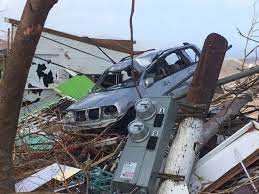Navigating Hurricane Season: Resilience in the US Virgin Islands
The United States Virgin Islands, a picturesque tropical paradise in the Caribbean, are renowned for their pristine beaches, azure waters, and vibrant culture. However, beneath this idyllic facade lies a harsh reality – the annual hurricane season that threatens to disrupt lives, infrastructure, and the very essence of island life. With an average of 12 tropical storms, six hurricanes, and three major hurricanes per season, these islands are subjected to the capricious nature of these meteorological behemoths. The hurricane season in the US Virgin Islands, spanning from May 15th to November 30th, brings both the menace of destruction and the testament of human resilience.

Damage on St. John, USVI from Hurricane Irma
The geographical location of the US Virgin Islands, situated within the hurricane belt, renders them highly susceptible to the wrath of these natural phenomena. Warm waters, typically between 80 and 85 degrees Fahrenheit, provide the energy needed for the formation and intensification of hurricanes. Atmospheric conditions also contribute to their development, as the islands lie beneath the steering currents that guide storms from Africa towards the Caribbean. As the hurricane season approaches, anticipation turns to preparation as islanders brace themselves for the impending tempests.
Preparation becomes a way of life during this season. The US Virgin Islands’ government, in collaboration with various agencies, implements a comprehensive disaster preparedness plan. Public awareness campaigns educate residents about the importance of emergency kits, evacuation routes, and securing property. Shelters are identified, and evacuation protocols are refined to ensure the safety of residents. The community rallies together, transforming these preparations into a shared effort, as individuals stock up on essential supplies and secure their homes.
As hurricane warnings loom, the atmosphere on the islands becomes palpably tense. Schools and businesses close, and residents rush to fortify their homes. Windows are boarded up, outdoor furniture is secured, and boats are relocated to safer harbors. Amidst this flurry of activity, a sense of unity emerges, as neighbors help one another, offering assistance and solace. The US Virgin Islands’ people have learned to respect the awesome power of these storms, drawing from a historical tapestry of past hurricanes that have left their mark on the islands and the people’s collective memory.
When the fury of a hurricane strikes, it can be both humbling and horrifying. Winds howl, rain pours in torrents, and the landscape is transformed into a chaotic battleground of nature. The sea surges, inundating coastal areas, eroding beaches, and flooding low-lying regions. Power lines are felled, leaving the islands in darkness, while communication networks falter. The devastation is undeniable, and the road to recovery appears daunting.
Yet, within the debris and destruction, a spirit of resilience emerges. The US Virgin Islands’ people have faced hurricanes throughout their history, each time rising from the ashes with renewed determination. After the winds have ceased and the waters have receded, the islands’ residents come together to rebuild their lives. Clearing debris, restoring power, repairing infrastructure, and aiding those most affected become a collective mission. It is during these times that the strength of human bonds shines through, transcending differences and reaffirming the islanders’ commitment to their community.
The US Virgin Islands’ resilience is not solely a product of necessity; it is deeply ingrained in the culture and heritage of the islands. The rich history of the islands, from the indigenous Taino people to the colonial eras of the Danish and Spanish, has forged a resilient spirit that echoes through generations. Celebrations and festivals, such as the Carnival, further underscore the islands’ resilience, reminding the people of their ability to overcome adversity and celebrate life.

Hurricane Irma hit the US Virgin Islands as a Cat 5 in 2017
In recent times, technology has played a crucial role in enhancing preparedness and response efforts. Advanced meteorological models provide more accurate forecasts, affording residents additional time to prepare. Communication networks, despite their vulnerability, have improved, enabling quicker dissemination of information and updates during and after hurricanes. Additionally, innovations in sustainable architecture and urban planning have led to the construction of more hurricane-resistant buildings, ensuring that the islands’ infrastructure can withstand the forces of nature.
The hurricane season in the US Virgin Islands is a reminder of the delicate balance between humanity and the natural world. While the islands’ beauty beckons tourists from across the globe, the hurricane season is a testament to the resilience and strength of the local community. As they confront the challenges posed by these annual tempests, the people of the US Virgin Islands stand united, embodying the spirit of survival and recovery that defines their remarkable culture. Through preparation, perseverance, and a profound connection to their land and each other, they navigate the tumultuous waters of hurricane season, emerging with a renewed sense of purpose and the knowledge that, despite nature’s fury, their resilience will always prevail.
